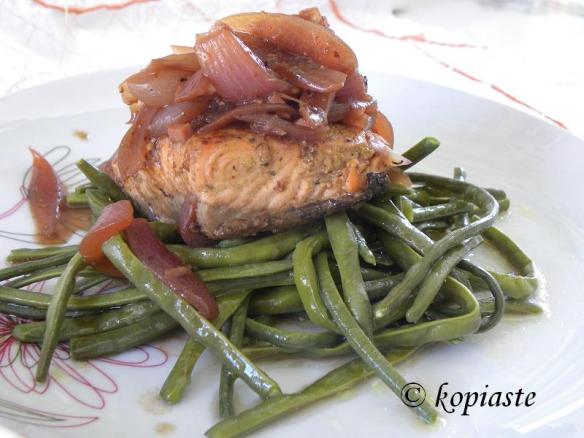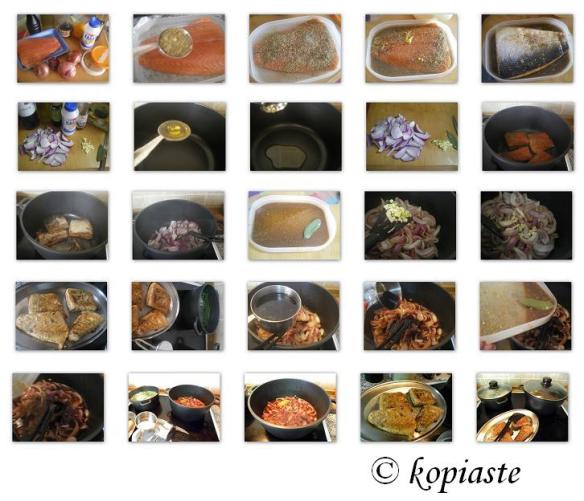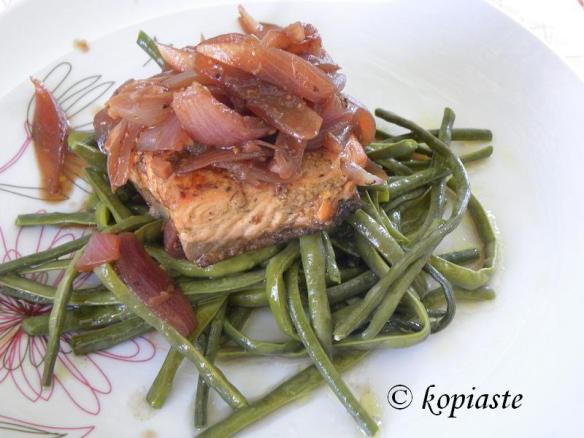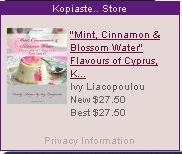 Μετάφραση της συνταγής πιο κάτω
Μετάφραση της συνταγής πιο κάτω
Once upon a time, like all fairy stories start, wedding traditions in Cyprus, were totally different.
Cypriot wedding traditions have changed over the years and prosperity in Cyprus has led modern couples to have their wedding parties in luxurious hotels, usually near the pool, which is elaborately decorated with flower arrangements and gourmet food is served.
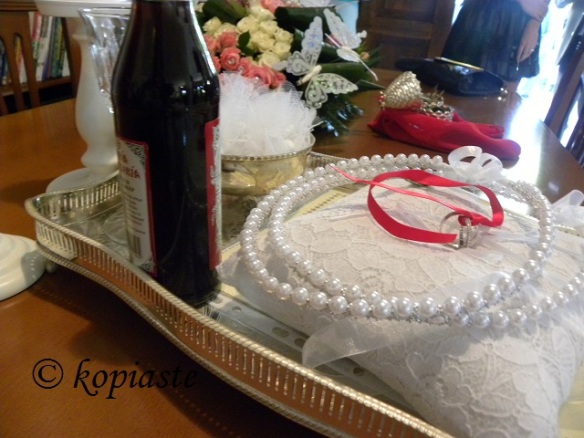
Μια φορά κι έναν καιρό, όπως αρχίζουν όλα τα παραμύθια, τα έθιμα του Κυπριακού γάμου ήταν αρκετά διαφορετικά.
Τα έθιμα του Κυπριακού γάμου τείνουν να εξαλειφθούν με το πέρασμα των χρόνων. Τα περισσότερα ζευγάρια προτιμούν να κάνουν δεξιώσεις σε πολυτελή ξενοεδοχεία, συνήθως έξω στην πισίνα που στολίζεται με πολλά λουλούδια και σερβίρονται πλούσια εδέσματα.

I recently wrote an article about “Old Cypriot Wedding Traditions” which was published in Status Magazine.
If you are in Cyprus you can find the article in the June – August issue of Status Magazine or you can also check it out online!
Πρόσφατα έγραψα ένα άρθρο σχετικά με τα παλιά έθιμα του Κυπριακού γάμου, στο Κυπριακό περιοδικό Status, που όμως επειδή είναι στα Αγγλικά, θα αναφέρω μερικά από τα έθιμα αυτά, σ’ αυτή την ανάρτηση.

Fortunately, some young couples still continue to follow traditions and prefer an “old style wedding” which includes some of the old traditions, such as the making of the bridal bed on Thursday before the wedding or making loukoumia tou gamou, which is the wedding dessert offered after the church ceremony and having vkiolarides (musicians, usually a violin and lute) accompanying all the rituals.
Before the ceremony the groom and bride get ready, in separate houses. The groom’s friends are there to help him shave and get dressed.
More attention is given to the preparation of the bride. Relatives, close friends and other guests gather at her house, while she is getting ready for the ceremony.
Some snacks and drinks are served while the relatives are waiting.
One of the traditions is that the bride writes the names of her single friends under her shoes and those names which are erased will be those getting married soon.. When the bride is ready, vkiolarides play the song: “Fonaxete ti mana tis narti na tini-zosi, tze na tis dosi tin eftzin tze na tin paradosi” summoning the bride’s mother, then the father and other relatives to bless her and give her away. During this ritual a red handkerchief is passed around the bride’s waist (a symbol of fertility) and head forming the sign of the cross, while incense is burning, to bless the bride and protect her against the evil eye. A very old tradition dating back to the Byzantine era.
When the time comes, both parties head to the church, following different routes. The musicians head the procession, playing music with all the guests following.
After the wedding ceremony the guests are invited back to the house where the wedding celebrations take place with music, dancing and lots of food, such as “ressi”, “ofton” baked meat and potatoes, “makaronia”, pasta, “koupepia”, stuffed vine leaves, “kioftedes”, meatballs and in many parts of Cyprus “kolokassi”, taro was the main dish, cooked with meat. Salads, halloumi cheese, yoghurt, olives and local wine accompany the above dishes.
The recipes are included in my cookbook Mint, Cinnamon & Blossom Water, Flavours of Cyprus, Kopiaste as well as in my e-cookbook.
In older times the newlywed couple would dance their first dance as a couple and guests and relatives used to pin money bills on their clothes, which was like a financial contribution for the couple to start their new life together. Nowadays money pinning has been replaced by cash or cheques given in closed envelope.

Παρόλα αυτά, μερικά ζευγάρια αντιστέκονται και εξακολουθούν να κάνουν παραδοσιακό γάμο, τηρώντας όλα τα παλιά έθιμα, όπως το στρώσιμο του κρεββατιού την Πέμπτη πριν το γάμο, την παρασκευή των λουκουμιών, που είναι το γλυκό κέρασμα μετά τον γάμο, ή το ζώσιμο της νύφης και το στόλισμα του γαμπρού, με τη συνοδεία των μουσικών σε όλες τις εκδηλώσεις.
Το ζώσιμο, είναι ένα τελετουργικό που γίνεται στο σπίτι της νύφης την ημέρα του γάμου, όταν τελειώσει το στόλισµα της νύµφης. Οι γονείς και οι παππούδες ή άλλοι συγγενείς της νύµφης, λίγο πριν την πορεία προς την εκκλησία για την τέλεση της θρησκευτικής τελετής του γάµου, θα αποχαιρετίσουν και θα δώσουν την ευχή τους στη νύφη.
Οι γονείς θα “ζώσουν” δηλαδή θα περάσουν γύρω από τη μέση και το κεφάλι της νύφης, ένα κόκκινο μαντήλι ή παλαιότερα ήταν ειδική κόκκινη υφασμάτινη ζώνη, ως σύμβολο γονιμότητας και θα καπνίσουν (λιβανίσουν) τη νύφη για να προστατευτεί από το κακό μάτι. Οι φκιολάρηδες (μουσικοί συνήθως με λαούτο και βιολί), τραγουδούν: “Φωνάξετε τον τζιύρη (κύρης = πατέρας) της να την ισφυκτοζώσει (να τη ζώσει σφικτά), τζιαι την ευτζιήν (ευχή) του που καρκιάς σήµερα να της δώσει.” μετά έρχεται η σειρά της μάνας “Φωνάξετε της µάνας της, νάρτει να την ιζώσει τζιαι να της δώσει την ευτζιήν τζιαί να την παραδώσει.” Οι φκιολάρηδες συνεχίζουν και φωνάζουν τους παπούδες κλπ. Το έθιμο αυτό έχει τις ρίζες του στο Βυζάντιο.
Ανάλογες ετοιμασίες γίνονται στο σπίτι του γαμπρού όπου γίνεται το ξύρισμα του γαμπρού, με τη συνοδεία των φκιολάρηδων και όταν έρθει η ώρα, οι πομπές με συνοδεία των φκιολάρηδων ξεκινούν από τα δύο σπίτια προς την εκκλησία.
Μετά την τελετή ακολουθεί γλέντι στο σπίτι όπου σερβίρεται το ρέσι καθώς και άλλα παραδοσιακά φαγητά όπως οφτόν με πατάτες, μακαρόνια του φούρνου, κουπέπια, κιοφτέδες, κολοκάσι με χοιρινό που σερβίρεται σε μερικές περιοχές της Κύπρου, σαλάτες, χαλλούμι, γιαούρτι, ελιές κλπ., και άφθονο τοπικό κρασί. Το παλιό έθιμο όπως το ζευγάρι να χορεύει και οι καλεσμένοι να καρφιτσώνουν πάνω στα ρούχα τους χαρτονομίσματα, έχει προ πολλού αντικατασταθεί με φακελάκια που περιέχουν λεφτά, για να ξεκινήσει το ζευγάρι το καινούργιο νοικοκυριό τους.

The article included a couple of lines about the traditional wedding food called “ressi”.
Ressi, is the traditional wedding food in Cyprus, which is a dish mainly with lamb or sometimes other meat, which is slowly cooked in large cauldrons over burning embers, until the meat and wheat berries are soft and become a thick pilaf.
To make ressi in the old times, the whole procedure started a few days before the wedding. The day before the wedding they would gather at the bride’s house and crack the wheat berries using hand mills. This was usually done by young couples. Large woven rugs were spread on the floor and the mills were placed on top. While the musicians were playing music, some single couples were cracking the wheat and others were dancing, interchanging frequently. The cracked wheat berries were then hulled, cleaned and carried to the nearest source of water, either the river or a fountain or well, accompanied again by the musicians, singing traditional weddings songs, in order to wash the berries.
On the wedding day the fatty lamb was cooked in large cauldrons outside in the yard on open air fires. The meat was slowly cooked for many hours until the meat fell off the bones. The bones were removed and the wheat berries were cooked with the meat until it became a thick pilaf. Ressi was occasionally stirred using a huge wooden stick, so as not to stick on the bottom of the cauldron. See a video of a recreation of the procedure of cracking the wheat during a traditional wedding.
Στο άρθρο υπήρχε και μια μικρή αναφορά στο Κυπριακό γαμοπίλαφο που λέγεται “ρέσι”. Το παραδοσιακό αυτό φαγητό γίνεται με αρνί και σιτάρι. Την παραμονή του γάμου μαζεύονται στο σπίτι της νύφης οι φίλου του ζευγαριού. Στρώνονται πέφτζια (χειροποίητα κιλίμια) και πάνω τοποθετούν τους χειρόμυλους, που ανάλογα μπορεί να είναι περισσότεροι από ένας. Ένα αγόρι και ένα κορίτσι κάθονται κάτω, δίπλα σε ένα χειρόμυλο και αλέθουν το σιτάρι ενώ με τη συνοδεία των φκιολάρηδων οι άλλοι χορεύουν. Τα ζευγάρια εναλλάσονται κατά τακτά διαστήματα. Αφού αλεστεί το σιτάρι, θα κοσκινιστεί και ξανά με συνοδεία μουσικών που παίζουν τραγούδια του γάμου, θα το πάνε στην πλησιέστερη πηγή νερού είτε στο ποτάμι, στη βρύση του χωριού ή σε πηγάδι για να το πλύνουν.
Την ημέρα του γάμου μαγειρεύεται το αρνί σε μεγάλα χαρτζιά (καζάνια) που στήνονται έξω στην αυλή. Το κρέας σιγοψήνεται για ώρες, μέχρι να λιώσει. Αφαιρούνται τα κόκκαλα και μέσα στον παχύ ζωμό του κρέατος βράζει το σιτάρι που γίνεται ένας πηκτός χυλός σαν πιλάφι. Θέλει γερά μπράτσα για το ανακάτεμα και συνήθως αυτή η διαδικασία γίνεται από άντρες που το ανακατεύουν με ένα τεράστιο κομμάτι ξύλο για να μην κολλήσει στο χαρτζί. Μπορείτε να δείτε ένα βίντεο με την αναπαράσταση της παρασκευής του ρεσιού εδώ.

Ressi, traditional Cypriot wedding food
Ingredients:
1 kilo lamb with fat on
A piece of fat from the tail (vakla)
4 cups of cracked wheat berries
1 red onion, finely chopped
2 litres lamb broth
Additional hot water
Salt and freshly ground black pepper
1/2 tsp cumin
1/4 cup lemon juice
Directions:
Wash the lamb and put it in a pot and cover with water. Bring to a boil, add salt, lower heat and simmer until it is well cooked and falls from the bones.
Remove from the heat and strain, reserving the broth. Set aside and when it can be handled, carefully remove all the bones, cutting the meat and fat into smaller piece.
Put back into the pot with the lamb broth. Add the onion, season with salt, pepper and cumin.and bring to a boil again.
Meantime wash the wheat berries and add to the meat. Lower heat and cook, stirring with a wooden spoon for about 45 minutes to an hour. Add more water, if necessary, until the berries are soft. Turn off the heat and leave it absorb all the water.
Serve warm with lemon juice on top and extra cumin.
Ρέσι, παραδοσιακό Κυπριακό φαγητό του γάμου
Υλικά:
1 κιλό άρνι (με λίπος)
Ένα κομμάτι βάκλα (λίπος από την ουρά)
4 κούπες σιτάρι
1 κόκκινο κρεμμύδι, ψιλοκομμένο
2 λίτρα ζωμό από το φαγητό
Επιπρόσθετο ζεστό νερό
Αλάτι και φρεσκοτριμμένο πιπέρι
1/2 κ.γ. κύμινο
1/4 κούπας χυμό λεμονιού
Εκτέλεση:
Πλένουμε το κρέας και το βράζουμε με αρκετό νερό να το σκεπάσει. Αφού βράσει το ξαφρίζουμε και προσθέτουμε αλάτι, χαμηλώνουμε τη φωτιά και το βράζουμε πάρα πολύ μέχρι να λιώσει το κρέας
Το βγάζουμε από τη φωτιά και το σουρώνουμε και κρατάμε το ζωμό. Το αφήνουμε λίγο να κρυώσει και το ξεκοκαλίζουμε, κόβοντας το κρέας και το λίπος σε μικρότερα κομμάτια.
Βάζουμε το κρέας με το ζωμό ξανά στη φωτιά και προσθέτουμε το κρεμμύδι, αλατοπίπερο και κύμινο.
Πλένουμε το σιτάρι και το ρίχνουμε στο ζωμό. Χαμηλώνουμε τη φωτιά και το βράζουμε περίπου 45 λεπτά έως 1 ώρα μέχρι να μαλακώσει. Εάν χρειαστεί προσθέτουμε και άλλο νερό. Σβήνουμε τη φωτιά και το αφήνουμε σκεπασμένο μέχρι να απορροφήσει όλα τα υγρά.
Το σερβίρουμε ζεστό με χυμό λεμονιού από πάνω. Εάν θέλουμε ρίχνουμε και επιπρόσθετο κύμινο από πάνω.

Kopiaste and Kali Orexi! / Κοπιάστε και Καλή Όρεξη!,































 Choco Orange cookies
Choco Orange cookies









